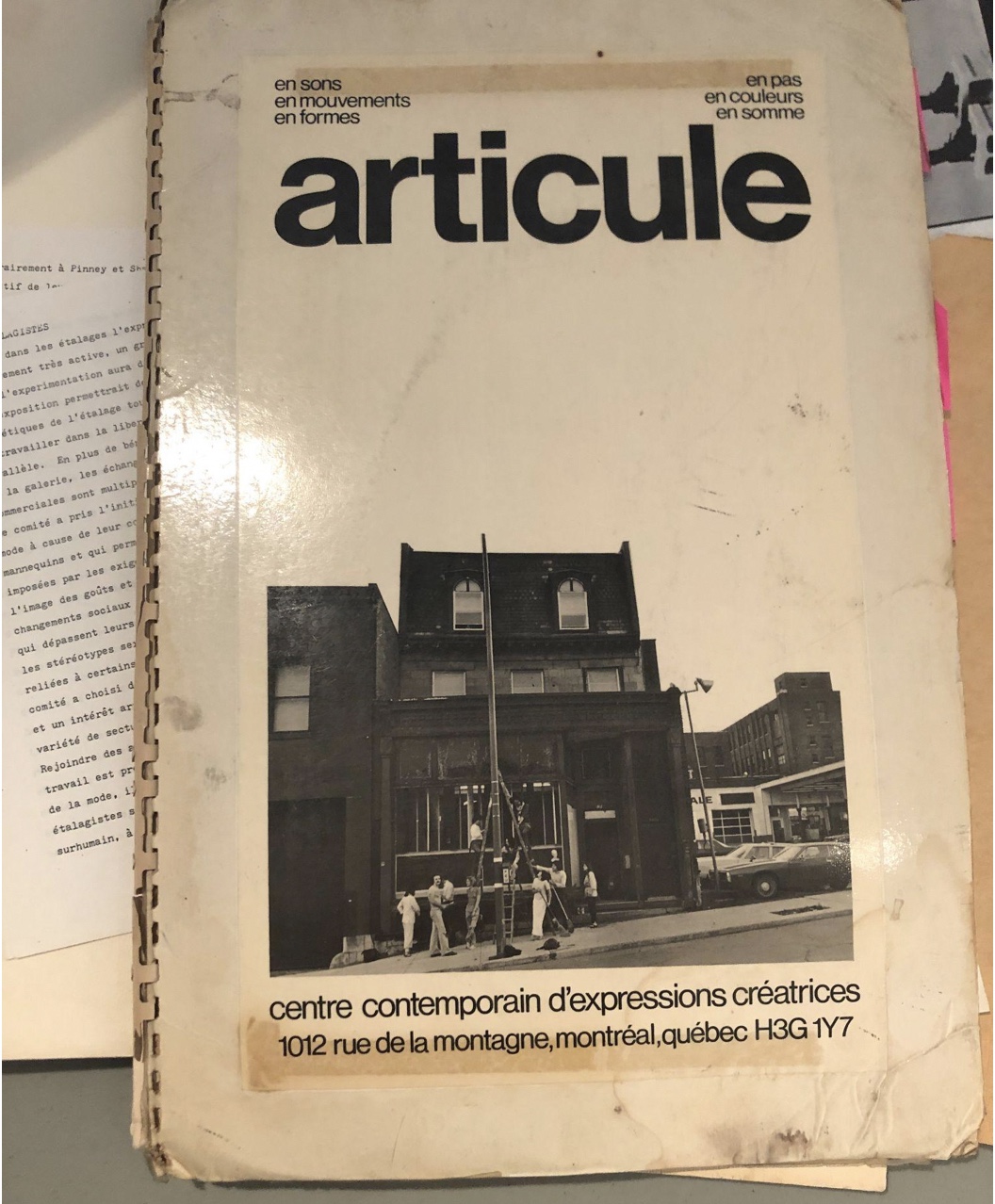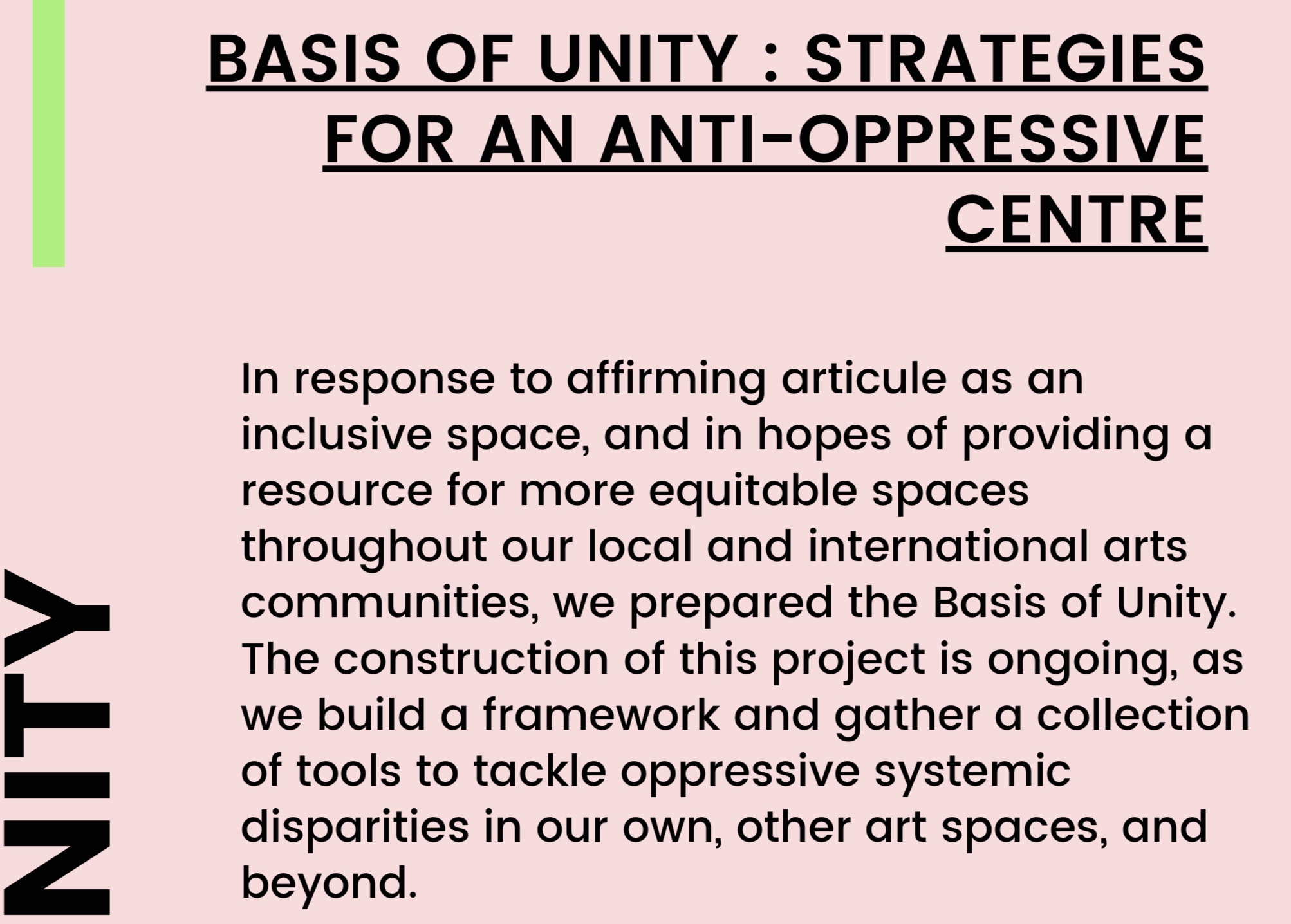articule (1979—)
by Amber Berson

Canadian artist-run centres were set up in the early 1970s as an alternative to the established exhibition models of public and commercial galleries, which favoured solo shows by established artists, and which exhibited and represented predominantly male artists. These spaces were committed to connoisseurship, and to the authoritative voice of the curator or gallery director. articule, established in Montréal in 1979, was created to be a bilingual exhibition space that presented contemporary visual art, dance, and performance art. A committee of members chose programming together and were practising artists themselves. Participating artists and audiences were at various stages of their careers and represented a spectrum of gender, class and racial realities.
As some of the first spaces to adopt conceptual art, artist-run centres were among the first spaces in Canada to be explicitly devoted to “contemporary” art as something distinct from the established canon of “modern” art. The artist-run centres that emerged in the 60s and 70s—just as conceptualism, video, and performance were ushering in the contemporary period—were key to this transition in Canada. Artist-run centres offered artists the ability to experiment without the responsibility of producing work for sale. The centres attempted to pay artists for their exhibition and allowed artists to network nationally at a time when conceptual performance art was emerging in Canadian art.
Artist-run centres, as spaces for exhibiting art and culture, are not unique to Canada; Sweden, for example, has a thriving community of similar spaces, perhaps because it too has a national financial support system for artists. However, artist-run centres occupy a more significant cultural position and are more numerous in Canada than anywhere else in the world, primarily because of the longstanding financial support system and policies in place since the creation of the Canada Council for the Arts in 1957, by the Canadian government, following recommendations in Vincent Massey’s 1949 Royal Commission on National Development in the Arts, Letters and Sciences, otherwise known as the Massey Commission.
Historically, artist-run centres in Canada have been funded by local, provincial and national arts councils. To qualify for funding and to be formally considered artist-run centres, centres must follow the not-for-profit arts organization model, must not charge admission fees, must be non-commercial, and must de-emphasize commercial art sales, as determined by both arts councils and regional artist-run centre umbrella organisations. This model encourages artists to exhibit experimental artwork. Artist-run centres generally operate according to traditional not-for-profit administrative models, including a board of directors and employees. Many centres, though not all, have active membership—made up of artists and community members. These members participate in jury processes and other administrative roles. Some artist-run centres operate as exhibition venues or production facilities, or they provide distribution platforms.
Scholars identify Intermedia Society, founded in Vancouver in 1967 by Jack Shadbolt and Glenn Lewis, as the “first multidisciplinary cooperative to receive funding from the Canada Council for the Arts,” though it self-identified as an artists’ association.[1] Some consider it to be the first artist-run centre, though that’s not how it conceived itself. Artist A.A. Bronson identifies A Space, founded in 1971 in Toronto, as the first true artist–run centre.[2]
In the spotlight: articule, 1979 to the present
Founded in 1979 in Montreal, articule was incorporated as a not-for-profit organization in 1980. Its initial mandate was to present the work of its artist members in a bilingual context, while engaging in a wider socio-political and artistic discourse that transcended the context of Montreal. The founders were young artists who wanted to create a space for professional exhibition and experimentation. Today, artist-run centres rarely program their own member-artists in exhibition contexts, and generally consider this type of activity to be a conflict of interest. However, this was precisely the impetus for creating articule (and other artist-run initiatives)—there were limited or no exhibition spaces for emerging, experimental artists and practices, and articule acted as a venue for artists to present their work (often for the first time) in a professional context at little or no cost to themselves. By programming member-artists, articule has been able to present work that is relevant and engaging to the community, thereby ensuring an audience.

In 2022, articule’s mandate is to operate as an open-access artist-run centre dedicated to the presentation of a broad range of contemporary art practices.[3] In addition to this mandate, articule uses a document titled “The Basis of Unity” to guide its administrative and programmatic decisions. This document lists a series of strategies for becoming an anti-oppressive art centre, starting with identifying ways that oppression occurs. It is an “ongoing” work in progress for articule’s staff, board, and external collaborators, “as [they] build a framework and gather a collection of tools to tackle oppressive systemic disparities in [their] own, [in] other art spaces, and beyond.”[4]
“The Basis of Unity” informs all levels of articule’s activities, from human resources and anti-harassment policies, to communications, to how the centre words its programming calls and contracts. It informs hiring and board elections. It goes beyond the mandate in that it informs articule’s community what to expect from articule and guides their participation. Artist-run centres began as opportunities for artists in Canada to challenge the status-quo for presenting art as well as for models of administrative decision making. Spaces like articule have continued that tradition. “The Basis of Unity” was adopted by articule’s members in 2018, but is the product of years, if not decades, of work at the centre and came about because the centre pushed to go beyond what was being asked by funders, keeping community needs at the forefront of decision making. It was developed following anti-oppression training offered to the centre’s membership as a way of developing public-facing policy—a contract for everyone involved in the centre. The document took several years to develop, and to translate, and is a living document, meaning it can be updated by the membership as a collective.
Programming then and now
articule’s programming has long focused on research and experimentation, but it has never been medium-specific. From very early on, articule included discursive activities such as artist talks, workshops, tours and conferences as part of its programming—for example, producing the artist-run magazine Discussion, which was published from 1981 to 1989. Today, articule continues to produce regular thematic conferences, artists’ talks, and workshops. articule has also been very involved in the performance art community. As a co-founding centre of VIVA! Art Actuel, “articule supports practices associated with performance art in its broadest terms and has made a significant contribution to the development of this discipline in the Montréal region.”[5]
Beyond lip service: Anti-oppression work at articule
Programming at artist-run centres should be a reflection of members’ interests and the centres’ mandates. At articule, this has meant considering how programming and equity overlap. In 2011, articule started to become an actively anti-racist and decolonial centre—a process which continues today. The Fabulous Committee is a member-formed sub-group within articule whose mandate is to “develop anti-oppression strategies to make the centre more inclusive and culturally diverse, this includes the artists we present through our programming as well as our internal structure (members, board, staff).”[6] Since the summer of 2012, the committee has implemented a series of changes at the centre that have resulted in a radical shift in the organization. These include consistent anti-oppression training, programming that centres and prioritizes BIPOC voices, constantly varied and multicultural representation on committees, the Board, in staffing and on the programming jury, as opposed to token representation. The Fabulous Committee, whose members led the drafting process, created a change in the “who” of the centre and “The Basis of Unity” shifted the “why.” Beyond the committee, tangible results of this process include Montréal Monochrome, “a conference aimed toward addressing the mis-and under-representation and systemic oppression of marginalized groups in Montréal’s contemporary art milieu. It grew into a multi-day interdisciplinary gathering and has become the centre’s annual flagship event.”[7]
Artist-run centres are often described as laboratories or incubators for artists. They are also spaces where risk-taking happens. Beyond artists and art work we see these risks manifesting in the daily administration of articule and other artist-run centres. Today, administrative models in museums, galleries and the general arts milieu recognize the value of engaging in diversity and inclusion practices beyond tokenistic action, in part because artist-run centres showed it was possible and necessary.
About the author
Amber Berson is a writer, curator, and Art Historian. She holds a doctoral degree from Queen’s University where her SSHRC-funded research examined artist-run culture and feminist, utopian thinking. She is based in Tiohtiá:ke, also known as Montreal, the unceded traditional territory of the Kanien’kehá:ka Nation. She/her pronouns.
Further reading
“About.” articule. Accessed March 6, 2021. https://www.articule.org/en/about.
Arnold, Grant, and Karen Henry, eds. Traffic: Conceptual Art in Canada 1965-1980. Edmonton: Art Gallery of Alberta; Halifax, NS: Halifax INK; Toronto: Justina M. Barnicke Gallery, Hart House, University of Toronto; Montréal: Galerie d’art Leonard & Bina Ellen Art Gallery; Vancouver, BC: Vancouver Art Gallery, 2012.
Bonin, Vincent, and Michèle Thériault, eds. Documentary Protocols: Protocoles Documentaires (1967-1975) / Sous La Direction De Vincent Bonin Avec La Collaboration De Michèle Thériault. Montréal: Galerie Leonard & Bina Ellen Art Gallery, 2010.
Bronson, A. A., René Blouin, Peggy Gale, Glenn Lewis, and Renée Baert. From Sea to Shining Sea. Toronto: The Power Plant, 1987.
Bronson, A. A., and Peggy Gale, eds. Museums by Artists. Toronto: Art Metropole, 1983.
Decentre: Concerning Artist-run Culture = à propos de centre d’artistes. Toronto: YYZ Books, 2008.
Davis, Heather, ed. Desire Change : Contemporary Feminist Art in Canada. Montréal: McGill-Queen’s University Press; Winnipeg: Mentoring Artists for Women’s Art (MAWA), 2017.
Gagnon, Monika, Cameron Bailey, and Richard Fung. Thirteen Conversations about Art and Cultural Race Politics. Montréal: Artextes Editions, 2002.
“History.” articule. Accessed December 5, 2020. https://www.articule.org/en/history.
Jessup, Linda, Erin Morton, and Kirsty Robertson, eds. Negotiations in a Vacant Lot: Studying the Visual Arts in Canada. Montréal: McGill-Queen’s University Press, 2014.
Khonsary, Jeff and Kristina LeePodesva. Institutions by Artists, vol. 1. Vancouver, BC: Fillip, 2012.
Nemiroff, Diana. “A History of Artist-run Spaces in Canada, with Particular Reference to Véhicule, A Space and the Western Front.” Master’s thesis, Concordia University, 1985.
Pourtavaf, Leila, ed. Féminisme électriques. Montréal: La Centrale, 2012.
Tayler, Felicity. Constellation and Correspondences: Networking between Artists, 1970-1980. Ottawa: National Gallery of Canada/Musée des beaux-arts du Canada; Montréal: Éditions Artextes, 2010.
Wallace, Keith, ed. Whispered Art History: Twenty Years at the Western Front. Vancouver, BC: Arsenal Pulp Press, 1993.
- Vincent Bonin and Michèle Thériault (eds), Documentary Protocols: Protocoles Documentaires (1967-1975) / Sous La Direction De Vincent Bonin Avec La Collaboration De Michèle Thériault (Montréal: Galerie Leonard & Bina Ellen Art Gallery, 2010), 18. ↵
- A.A. Bronson and Peggy Gale, eds., Museums by Artists (Toronto: Art Metropole, 1983), 32. ↵
- “About,” articule, accessed March 6, 2021, https://www.articule.org/en/about. ↵
- “About,” articule, accessed March 6, 2021, https://www.articule.org/en/about. ↵
- “History,” articule, accessed December 5, 2020, https://www.articule.org/en/history. ↵
- “History,” articule, accessed December 5, 2020, https://www.articule.org/en/history. ↵
- “History,” articule, accessed December 5, 2020, https://www.articule.org/en/history. ↵
An artist-led gallery, production centre, or distribution platform, commonly found in Canada from the 1970s onwards.

